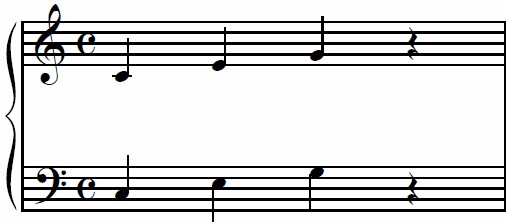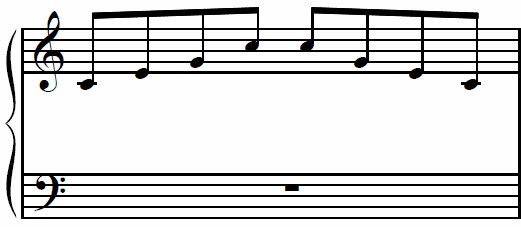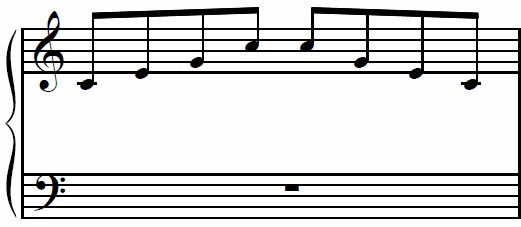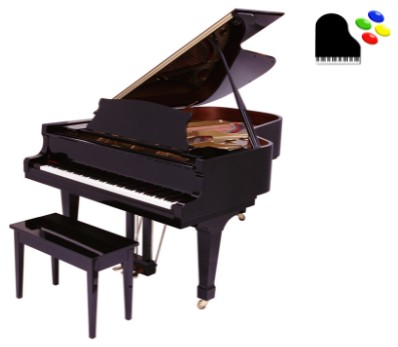Without chords, music would sound very thin and hollow. Most instrumentalists and recording artists utilize chords to enrich their music. Chords are performed with instruments as well as the human voice.
A Chord on the piano is a series of three or more notes that are played in unison. Chords are referred to as harmony. They can be played in the left, right, or both hands. They often consist of combinations of black and white keys and can span through several registers of the keyboard.
Triads
Triads are three note chords. There are four categories of triads: Major, minor, diminished and augmented.
A Major triad is a three note chord based on the tonic or the “home note” of a Major key of music. It consists of the root, third and fifth intervals. Intervals are just the distance between notes.
Key of C Major

C Major Triad

A minor triad is a three note chord based on the tonic of a minor key of music. It’s similar to a Major triad, only the third is lowered a half step (or one key).
C minor Triad

A diminished triad is a three note chord that consists of the root, minor third, and a diminished (lowered) 5th tone.
C Diminished Triad

An augmented triad is a three note chord that consists of the root, major third and augmented (raised) 5th tone.
C Augmented Triad

The following shows the formula for all four types of triads
| Major | Root-3rd-5th |
| Minor | Root-minor 3rd-5th |
| Diminished | Root-minor 3rd-diminished 5th |
| Augmented | Root-3rd-augmented 5th |
Chord Inversions
Triads can be played in 3 different positions: Root position, 1st inversion and 2nd inversion.
Major triad Inversions
C Major Root Position

C Major 1st Inversion

C Major 2nd Inversion

minor triad Inversions
C minor Root Position

C minor 1st Inversion

C minor 2nd Inversion

Diminished triad Inversions
C Diminished Root Position

C Diminished 1st Inversion

C Diminished 2nd Inversion

Augmented triad Inversions
C Augmented Root Position

C Augmented 1st Inversion

C Augmented 2nd Inversion

The following shows the formula for Inversions of all four triad types
| Triad Type | Root Position | 1st Inversion | 2nd Inversion |
| Major | Root-3rd-5th | 3rd-5th-Root | 5th-Root-3rd |
| minor | Root-m3rd-5th | m3rd-5th-Root | 5th-Root-m3rd |
| Diminished | Root-m3rd-dim5 | m3rd-dim5th-Root | dim5th-Root-m3rd |
| Augmented | Root-3rd-aug5 | 3rd-aug5th-Root | Aug5th-Root-3rd |
With these different types of triads along with their inversions, the possibilities to play any song is virtually unlimited. Triads are the workhorses of most any song. You really only need Major and minor triads to play the harmony of any popular song. Diminished and augmented triads can accentuate the harmony but aren’t as essential.
Extended Chords
Extended chords encompass a variety of tones that are added to triads. These can include the 7th, 9th,11th, and.13th tones. These are extended tones beyond the 7th. Understanding the concept of using these extended tones gives you the tools you need to create these extended chords and utilize them in your music.
7th Chords
A 7th chord will use the 7th tone of a Major scale with a Major triad. It’s specifically referred to as a Major 7th chord.
C Major 7th Chord

There is also the flatted 7th tone. It’s added to a Major chord to create what is simply called a 7th chord. It’s also referred to as a dominant 7th chord.
C Dominant 7th Chord

7th chords can be confusing for a beginning chord piano player because there are two types of them. One very helpful way to distinguish these two 7th tones from one another is their proximity to the root of the chord as well as their sound.
A Major 7th tone is located 7 tones above the root. For example, the Major 7th tone of C is B.

The flatted 7th tone is located a minor 7th tone above the root. For example, the flatted 7th tone of C is B flat.

Another way to distinguish the two types of 7th chords is to simply listen to the difference between them. The Major 7th has a smooth sound while the dominant 7th chord has a dissonant sound.
Minor 7th Chords
A minor 7th chord will use the 7th tone of a minor scale with a minor triad. It’s specifically referred to as a minor 7th chord.

There is also a minor/Major 7th chord. It consists of a minor chord with a Major 7th tone. However it is a very rare chord that’s only used in jazz music most of the time.

Beyond 7th chords
Extended chords beyond 7th chords will include the flatted or Major 7th tones without explicitly stating it. The flatted 7th tone is always implied with 9th,11th and 13th chords. The word “Major” will be used if the chord contains the Major 7th tone.
9th Chords
A 9th chord will use the 9th tone of a Major scale with a Major triad. It’s specifically referred to as a 9th chord. This tone is located 9 tones above the root. The Major 9 chord contains a Major 7.
C Dominant 9th Chord

C Major 9th Chord

11th Chords
An 11th chord will use the 11th tone of a Major scale with a Major triad. However, the 3rd will often be omitted because the 3rd and 11th tones clash with one another. This tone is located 11 tones above the root.
C Major 11 Chord

13th Chords
A 13th chord will use the 13th tone of a Major scale with a Major triad. This tone is located 13 tones above the root. The Major 13 chord will contain a Major 7th.
C Dominant 13th Chord

C Major 13th Chord

Suspended Chords
A suspended chord is one in which the 3rd is suspended for another tone in the chord.
Sus4 Chords
A sus4 chord is a suspended chord in which the 4th tone of a Major scale is played in place of the 3rd.
C sus4 chord

A sus2 chord is a suspended chord in which the 2nd tone of a Major scale is played in place of the 3rd.
C sus2 chord

Altered Chords
An altered chord is an extended chord in which the 5th or 9th tones are raised or lowered in any combination. They can be Major, minor or suspended chord qualities.
The following are just a few examples of altered chords.
C7 sharp 9 sharp 5

C7 flat 9 sharp 5

Cm7 flat 5

C dim7

Chord Voicings
Earlier we covered chord inversions. This usually refers to triads/chords that don’t have the root on the bottom of the chord. A Chord voicing refers to a specific arrangement of the chord tones. Voicings give a chord a more pleasing sound although a particular voicing is subjective to the listener.
By definition a chord is a stack of 3rd intervals. But building chords this way doesn’t give chords the most satisfying sound. Voicing chords in various ways can make them sound fresh and more interesting. Any given chord can have virtually an infinite number of voicings.
Here’s an example of an extended chord with a stack of thirds also known as a closed voicing.
Cm13 closed voicing

Voicing the same chord may look something like this:
Cm13 open voicing

Arpeggios
Even though the definition of a chord is several notes played in unison, it’s not the only option to play chords. Arpeggios are broken chords. In other words, the tones of the chord are played individually instead of in unison.
C Major triad

C Major triad played as an arpeggio

Just like chord voicings, arpeggios can be played in a variety of ways making the options available virtually infinite.
C Major arpeggio variation

Playing Chords with Rhythm
When the situation calls for it, chords can be played in various rhythms. This may be the case with different genres or styles of music. Chords can also be played more rhythmically on the piano if it’s part of an ensemble in which other instruments are present.
Rock rhythm with in C

Final Thoughts
Playing music on the piano in the context of chords can be very satisfying as opposed to simply playing notes. Unfortunately from a traditional standpoint, the piano as an instrument has always been more formal in nature compared to more contemporary instruments such as the guitar.
On the positive side, playing the piano/keyboard as a contemporary instrument has grown over the last several years with the advent of music technology in the way of digital keyboards and pianos. By learning the chord fundamentals covered in this article, an aspiring piano player can advance much faster in skill than those with the traditional piano lessons of the past.
Until next time, Go Play!
Greg Lee
Latest posts by Greg Lee (see all)
- What is a minor/Major 7 Chord? - October 26, 2023
- 7 Chord Substitutions that Professionals Use - October 19, 2023
- 5 Simple Chord Tricks to Sound Amazing - October 5, 2023




